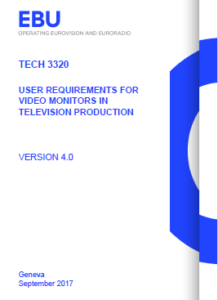The EBU, the trade association that represents public broadcasters in Europe, has defined a new version of its requirements for reference monitors. Version 4 has been amended to allow for high dynamic range (HDR) and wide colour gamut (WCG) for UHD and 1080P HD monitors.
There are a number of different grades of monitor in the requirements, with Grade 1 being the highest quality. However, for V4, the EBU has split this into a Grade 1A and a Grade 1B with the key differentiation being that Grade 1B monitors may not be capable of reproducing the full range of colour or brightness defined in a standard, but will otherwise fulfil all the requirements of a Grade 1A monitor. The EBU described this as a ‘novel approach’ to dealing with the gap between the standards and what is available in the market.
The new specification (Tech 3320) says that the Grade 1B level may be withdrawn in the future.
Although support for both PQ and HLG is recommended for Grade 1A and 1B, manufacturers could choose to support only one and the requirements are different.
Both 1A and 1B HLG monitors need to be able to produce a peak brightness (1%) of greater than or equal to 1,000 cd/m², while Grade 2 monitors need to offer 600 cd/m². Grade 1B monitors may have a limited chrominance range compared to 1A monitors, but must be able to show ‘false colours’ or otherwise indicate the areas of the image where they are not 100% accurat. For Grade 1 HDR HLG monitors, a 75% full screen uniform field signal should be displayed without power limiting. (Output level 203 cd/m² when digital level 940 is set to 1000 cd/m² ).
For PQ, a Grade 1A monitor must be capable of 10,000 cd/m² (!), while Grade 1B and Grade 2 need to match the HLG versions, with 1,000 cd/m² and 600 cd/m², respectively.
For Grade 1A HDR PQ or the Grade 1B HDR PQ monitors, a 199.2 cd/m² (code value 592, 10-bit full range) full screen, uniform field input signal must be displayed without power limiting.
There are very detailed requirements for colour gamut coverage, but Grade 1 HDR monitors have to be >90% of BT.2020 for Grade 1A, and >60% for Grade 1B and Grade 2. Contrast must be 10,000:1 (simultaneous).
Analyst Comment
The need for different grades is really about OLEDs, which lose chromaticity as they start to produce high peak brightness and so we would expect OLEDs to be in the 1b or 2 class for now. They might get into Grade 1A for HLG, but not for PQ in the foreseeable future. Although I can see the point of having the top level of brightness for PQ matching the BT.2100 standard, it seems a bit over the top to expect PQ monitors to be able to reach 10,000 cd/m² . It seems to me that even the best monitors in the near future may be sold as HLG (1a) and PQ (1b).
The requirement for the 75% output of 203 cd/m² reflects the comments made by Andrew Cotton of the BBC in his talk on HLG (BBC Updates on HLG Status)

